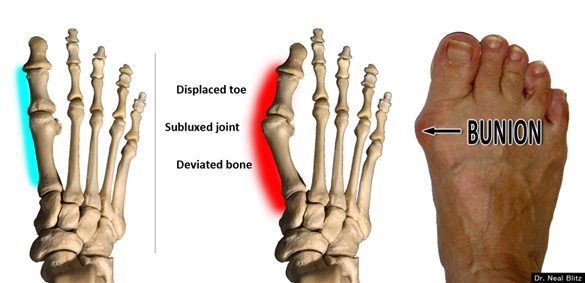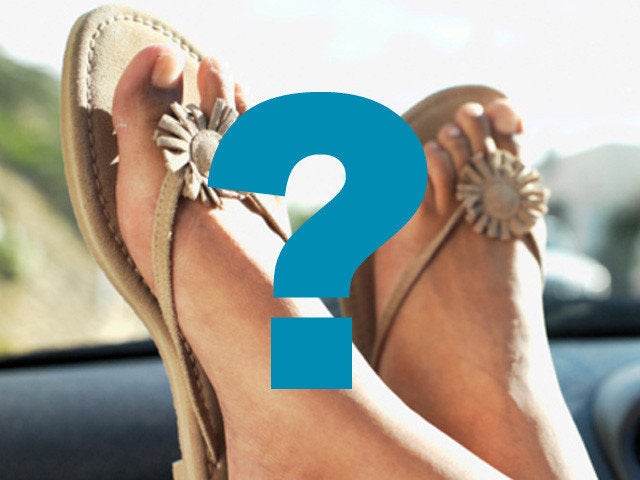Look down at your feet -- would you know if you have a bunion?
Many people know the term 'bunion' and that it occurs on a foot, but don't know exactly what a bunion is.
Most people think a bunion is an abnormal growth of bone at the base of the big toe. This is incorrect (at least in most cases). A bunion is actually a structural problem where the big toe joint becomes subluxed and drifts towards the smaller toes. A displaced bone, called a metatarsal, becomes prominent on the inside of the foot. The bunion simply refers to the enlarged prominent 'knobby' area.

Bunions may progress in size and severity. A bunion may start of as minor issue and, over time, may develop into a severe disfiguring foot deformity. See below:
So if you have bunion, here are 10 important things you should know, as you consider treatment:
- Not all bunions are painful.
- The medical term is hallux abducto valgus.
- They come in different sizes: small, medium, large or severe.
- Genetics. You may have inherited your grandmothers feet.
- They occur more often in women than men.
- Pointy-toed shoes and high heels may result in bunions.
- Bunions may get bigger over time, or not.
- The bunion may cause problems with the lesser toes.
- Non-operative treatments are mostly aimed at treating the symptoms.
- Surgical treatment goals are to realign the natural position of the toe.
There is not a specific point when bunion sufferers 'must' start treatment despite the bunion severity. Some people begin treatment with the smallest bunion while others neglect the condition until severe. Reasons to seek medical treatment are:
How to limit progression of a bunion?
It is important to understand that not all bunions become worse (or bigger). Some bunions never change in size. Others may progress onto a major foot deformity. Genetics play a big role and you may be 'destined' to develop a 'bad' bunion. Below are non-surgical measures to mitigate pain as well as limit the progression.
Smart Shoe Selection: Avoiding shoes that are bad for your foot health may be the best preventive measure you can take. Pointy toes shoes directly pushes on the big toe inappropriately, and in my opinion are 'bunion formers.' If the bunion becomes irritated, then spot stretching the shoe limits symptoms. High heels may also contribute to bunions due to altered foot mechanics -- so limit time in them. Flip flops are considered a "poor footwear" choice by most health care professionals. Minimalist shoes seem to be a better lightweight alternative. Counteract Muscle Spasms: Muscle spasms within the foot are often due to a muscular imbalance, and an important warning sign that muscles are trying to stabilize bone structure. Strained muscles are less effective at stabilizing the foot and a bunion may progress. Deep massage and mineral foot soaks ease tension in the foot. Foot Strengthening: It's important to keep your foot muscles strong to counteract the muscular imbalance. Perform simple toe exercises daily -- such as picking up marbles (or a handkerchief) with your toes. Commercially available toe exercising devices may have therapeutic benefits but studies do not exist demonstrating efficacy. Arch Supports: Bunions and foot deformities tend to occur in people with flat feet and/or ligamentous laxity. Arch supports provide extrinsic structure and promote a more 'proper' alignment and may limit bunions from getting bigger. Over the counter inserts are a good first start. Doctor-prescribed molded orthotics have the benefit of being custom to your foot and therapeutically tweaked.Pain Medication (Oral & Topical): Non-steroidal anti-inflammatory medication is commonly recommended to decrease pain and inflammation. Topical treatments also help manage inflammation and pain symptoms. Capsaicin cream/ointment (derived from spicy chili peppers) is a potent pain reliever that works via a neurochemical pathway. Be sure that the skin overlying the bunion is intact, otherwise capsaicin will cause an intense burning sensation. Topical products containing methyl salicylate distract the pain perception by causing cooling/warming skin sensations. Topical corticosteroid cream may temporarily reduce inflammation and should be used intermittently because it may cause thinning of the skin as well as hypopigmentation. Bunion Padding: A pad limits direct pressure and may prevent the pain cascade altogether. Chronic bunion inflammation can result in deeper bone problems, so prevention is beneficial. More importantly, a properly placed pad may provide a physical blockade that prevents the bunion from pushing out. Pads may be composed of felt, moleskin or gel. Toe Spacers & Bunion Splints: The purpose of this intervention is to physically place the big toe in a more normal position. A toe spacer (often made of silicone) is worn while walking. A bunion splint is a useful device (worn while sleeping) to physically realign the big toe. If you have a bunion, do what it takes to take care of your feet and prevent progression. If the above measures don't help, then surgery may be inevitable.
To learn more about Dr. Blitz, please visit www.nealblitz.com
Support HuffPost
Our 2024 Coverage Needs You
Your Loyalty Means The World To Us
At HuffPost, we believe that everyone needs high-quality journalism, but we understand that not everyone can afford to pay for expensive news subscriptions. That is why we are committed to providing deeply reported, carefully fact-checked news that is freely accessible to everyone.
Whether you come to HuffPost for updates on the 2024 presidential race, hard-hitting investigations into critical issues facing our country today, or trending stories that make you laugh, we appreciate you. The truth is, news costs money to produce, and we are proud that we have never put our stories behind an expensive paywall.
Would you join us to help keep our stories free for all? Your contribution of as little as $2 will go a long way.
Can't afford to donate? Support HuffPost by creating a free account and log in while you read.
As Americans head to the polls in 2024, the very future of our country is at stake. At HuffPost, we believe that a free press is critical to creating well-informed voters. That's why our journalism is free for everyone, even though other newsrooms retreat behind expensive paywalls.
Our journalists will continue to cover the twists and turns during this historic presidential election. With your help, we'll bring you hard-hitting investigations, well-researched analysis and timely takes you can't find elsewhere. Reporting in this current political climate is a responsibility we do not take lightly, and we thank you for your support.
Contribute as little as $2 to keep our news free for all.
Can't afford to donate? Support HuffPost by creating a free account and log in while you read.
Dear HuffPost Reader
Thank you for your past contribution to HuffPost. We are sincerely grateful for readers like you who help us ensure that we can keep our journalism free for everyone.
The stakes are high this year, and our 2024 coverage could use continued support. Would you consider becoming a regular HuffPost contributor?
Dear HuffPost Reader
Thank you for your past contribution to HuffPost. We are sincerely grateful for readers like you who help us ensure that we can keep our journalism free for everyone.
The stakes are high this year, and our 2024 coverage could use continued support. If circumstances have changed since you last contributed, we hope you’ll consider contributing to HuffPost once more.
Already contributed? Log in to hide these messages.


